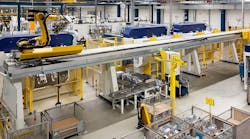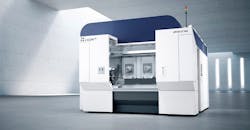“Sustainability” is an important standard for Hengst Filtration, the Nordwalde, Germany, manufacturer of automotive and commercial-vehicle filtration systems. Recently, the business installed two automated machining cells, supplied together with fixtures and robots by LiCON MT GmbH.
The new work cells, based on five Type LiFLEX II 766 twin-spindle machines, were selected in order to machine a new series of car and truck filter housings that had formerly been produced as diecastings.
In the larger cell, Hengst produces housings for truck filters on three LiFLEX twin-spindle machines. The other two machines produce car filters.
The new machines provide the same output as single-spindle machines, but require 40% less floorspace, which improves the shop’s productivity per square meter.
The Hengst production line had primarily used four-axis, single-spindle machines: to machine five sides of the parts, at least two clampings were needed. With the new LiCON five-axis machines the parts could be completely machined in one clamping. This avoids re-clamping errors.
“For easy scalability it is important that the workpieces are completely machined in one machine,” recalled Hengst Filtration project leader Hans-Joachim Daum. “Based on this, every additional machine will expand capacity. With the LiCON machining centers, this succeeded not only with the car filter housings but also with the truck filter housings."
“The cubic working envelope of the machining centers is designed with window fixtures in mind, so that five-sided machining is possible,” explained Nils Baumgartner, LiCON’s account manager at LiCON.
MQL replaces coolant, saves energy
Typically, emulsion had been the lubrication method for machining at Hengst Filtration, however in this case Minimum Quantity Lubrication (MQL) was selected. A tool-specific, oil-mist mixture is transported to the cutting edge through cooling channels in the tool. During the process development, the tool and process specific dosage parameters can be optimized and saved in the NC program. This ensures that the machined parts are “quasi-dry” when they are removed from the machining center. Contamination of the machine and the environment using coolant is avoided. The circulation of coolant via pumps and drive motors is eliminated, resulting in significant energy savings.A LiFLEX twin-spindle machine requires approximately 15 kW for MQL. In comparison to using coolant in machining centers there are savings in electrical energy of at least 10 kWh per machining center. Over a year’s time of 5,000 operating hours there are savings of 50,000 kWh per machining center and 250,000 kWh for all five machining centers.
At Hengst Filtration two distinctly different size parts are machined using the same technology. On this basis, the machining of a large part and a small part on the same size machine was selected, however they are distinctly different in the loading concept. In this case, the modular LiCON concept is an advantage.
The LiFLEX II 766 can be loaded three ways: direct load of the A-axis, double trunnion concept with two A-axes or a pallet changer. For machining of large parts with their commensurate longer machining cycles, the LiFLEX II 766 i DL B2 direct load was chosen. For parts loading and unloading, the machine is idle.
However, this is a minor operation relative to the cycle time so a second set of clamping devices for loading parallel to the main time would not be worthwhile. And the additional effort of monitoring part quality is reduced by 50%.
Machining the smaller, automotive filter housing there is a completely different scenario. Marco Gerhard, industrial engineer at Hengst Filtration, explained: “Due to the smaller cubic size of the car housings, the cycle time is significantly shorter than of the truck filter housings, so that unloading/loading simultaneous to machining is the more economical solution of the three variations. Therefore, the pallet-changer version machining center was installed. In this machine it is even possible to mount two fixtures per spindle side. Therefore, two filter housings are machined per spindle, thus resulting in four completed parts per cycle. This improved the net cycle time per part by 15 %.”
Automation properly configured and still flexible
Three machining centers were installed to process the larger housing. These were loaded via a robot mounted on a gantry, so that the parts would be loaded/unloaded from above. The LiCON designed gripper consists of four grippers so that two finished parts are unloaded and two raw parts can be loaded by the robot in the same position. This ensures that the raw parts will be targeted properly in the fixtures.
The production cell for smaller parts consists of two machining centers opposed to each other, with one robot being able to service both machines. In both production cells the raw parts are manually loaded onto a raw part conveyor. The buffer is large enough to allow for unattended operation during operator lunch breaks.
“Flexibility is important. On that basis we also wanted access to the machines for manual loading. This allows us to process smaller lots of older designs, on one of the three twin-spindle machines. This makes the gantry robot a ‘good concept’," explained production manager Michael Cedrola.
Production systems with a high level of automation allow for transparent data management. So all the parameters of this project can be observed per part type. Countless relevant data is transferred from the machining centers to a central data storage.
In addition, other sensor systems like drill-breakage monitoring and machining quality (as a function of vibrations) can be analyzed for further service requirements.
Single-source integrated solutions
According to Hengst Filtration’s industrial engineering team leader Alf Bönisch, it is important that extensive projects like this one should have as few points of contact as possible, to ensure success. “LiCON supplies the entire installation as a turnkey-supplier including fixtures and automation. Therefore, responsibility is with one source.
The robot hand is very complex. It has four grippers: for holding two raw parts and two finished parts. For an effective interface to both fixtures, it was beneficial that both fixture and robot grippers were developed and built by the same supplier.
To minimize the process development time, LiCON simulated the entire process virtually and qualified the system using simulation programs. This saved valuable time,” according to Bönisch.







